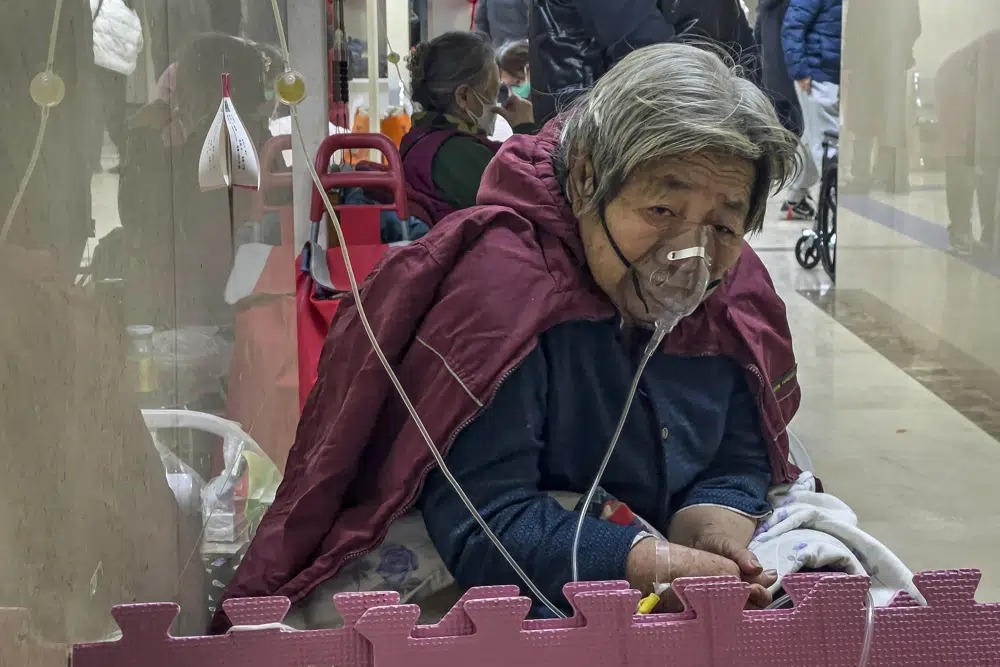Patients, mostly older people, laid on stretchers in hallways or took oxygen while sitting in wheelchairs as a COVID-19 outbreak stretched public health facilities’ resources in China’s capital Beijing, even after its reported peak.
The Chuiyangliu hospital in the city’s east was packed Thursday with newly arrived patients. Beds ran out by midmorning, even as ambulances continued to bring more people in. Hard-pressed nurses and doctors rushed to take information and triage the most urgent cases.
The crush of people seeking hospital care follows China abandonment of its most severe pandemic restrictions last month after nearly three years of lockdowns, travels bans and school closures that weighed heavily on the economy and prompted unusual street protests in a country that quashes political dissent.
The outbreak appears to have spread the fastest in densely populated cities first. Now, authorities are concerned as it reaches smaller towns and rural areas with weaker health care systems. Several local governments began asking people Thursday not to make the trip home for the upcoming Lunar New Year holiday, signaling lingering worry around opening up.
Overseas, a growing number of governments are requiring virus tests for travelers from China, saying they are needed because the Chinese government is not sharing enough information on the outbreak. The European Union on Wednesday “strongly encouraged” its member states to impose pre-departure COVID-19 testing, though not all have done so.
Italy — the first place in Europe where the pandemic exacted a heavy toll in early 2020 — became the first EU member to require tests for passengers from China last week, and France and Spain followed with their own measures. That followed the imposition by the U.S. of a requirement for a negative test result within 48 hours of departure.
China has criticized the requirements and warned of countermeasures against countries imposing them.
World Health Organization head Tedros Adhanom Ghebreyesus said Wednesday he was concerned about the lack of outbreak data from the Chinese government.
At a daily briefing Thursday, Chinese Foreign Ministry spokesperson Mao Ning said Beijing has consistently “shared information and data with the international community in an open and transparent manner.”
“At present, China’s COVID-19 situation is under control,” Mao said. “Also, we hope that the WHO secretariat will take a science-based, objective and impartial position to play a positive role in addressing the pandemic globally.”
Local government appeals to avoid travel during the Lunar New Year holiday comes days before the formal lifting of many remaining restrictions — some already not being enforced — on Sunday.
“We recommend that everyone not return to their hometowns unless necessary during the peak of the outbreak,” the government of Shaoyang county in Hunan province in central China said in a notice dated Thursday. “Avoid visiting relatives and traveling between regions. Minimize travel.”
Similar appeals were issued by Shouxian county in Anhui province southeast of Beijing and the cities of Qingyang in Gansu province in the northwest and Weifang in Shandong on the east coast.
The appeals, which harkened back to the last few years of strict pandemic restrictions, showed that some officials remain nervous about lifting them too quickly.
The Weifang government notice said residents should celebrate the holiday with video and phone gatherings.
“Avoid visiting relatives and friends to protect yourself and others,” it said.
Despite such concerns, Hong Kong announced it will reopen some of its border crossings with mainland China on Sunday and allow tens of thousands of people to cross every day without being quarantined.
The city’s land and sea border checkpoints with the mainland have been largely closed for almost three years and the reopening is expected to provide a much-needed boost to Hong Kong’s tourism and retail sectors.
(AP)












2 Responses
> The outbreak appears to have spread the fastest in densely populated cities first.
Much alternative research suggests the brunt of the ‘covid’ problem (it’s never truly been isolated as a virus) is due to 5G. In China, toward the end of ‘2019, 5G was first rolled-out in Wuhan Province – where people were first reported as taking sick from the ‘new disease, Covid’. Urban areas have much more radiation exposure.
> Italy — the first place in Europe where the pandemic exacted a heavy toll in early 2020…
Milan and northern Italy was the next region west that rolled-out 5G (in early 2020). The ‘radiation plague’ skipped over Russia’s 11 time zones – where 5G had not yet been ‘rolled-out’. (Incidentally, Russia is the only bureaucracy that considers ‘electric field based radiation exposure’ as a legitimate medical diagnosis in depression, and not just something psychosomatic.)
> China has criticized the requirements and warned of countermeasures against countries imposing them.
They are not interested in science, but have put wireless surveillance ahead of all (which 5G has made possible), and now criticize other countries that have a modicum of respect for attempting to get close to finding the cause of these outbreaks (though the PCR test and ‘covid clot shot’ protocols are both false).
> …we hope that the WHO secretariat will take a science-based, objective and impartial position to play a positive role in addressing the pandemic globally.”
The WHO has long ago become a puppet of Bill Gates, the WEF, and other ‘science-falsification’ cohorts. They are after wireless telecom and vaccine industry monies.
Glyphosate pesticide (Roundup) typical presence in GMO and non-organic foods especially, in these times, is another well-researched cause of ‘covid-like’ symptoms.
So, the Chinese virus finally catches up to the Chinese!